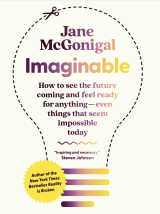McGonigal: I hit my limit of reading headlines and news stories that described world events like the pandemic and extreme weather as “unimaginable”. In recent years, we’ve had so many shocking political events in the United States, and extremism and new kinds of protests and social movements, and this word just kept showing up. It was exasperating because we’d predicted so much of this for a long time. It wasn’t that they were “unimaginable” or “unthinkable,” we just didn’t want to think about them because it’s stressful and it makes us feel anxious. Or, we didn’t have the tools or information to vividly imagine what living through a pandemic would be like or how social media might fuel extremism. I wanted to write a book to help people confidently see that no future is unthinkable because we refuse to think about it, or no future is unimaginable because we don’t believe that transformative change is possible.
One of the book’s driving ideas is urgent optimism. What is urgent optimism and why should we strive for it?
McGonigal: Urgent optimism means we definitely need to act and not sit around and wait for the future to happen. We will take action to shape how the future turns out. The optimism comes from a sense of agency or self-efficacy where the future is shaped by actions that we take today to prepare, plan and change the way the world works. To stay engaged with the future we have to fuel the fires of hope and creativity. We have to feel that the future can be better due to our own actions. At the end of the day, urgent optimism allows for the mental flexibility to internalize a realistic sense of hope that is grounded in an awareness of risks and threats, but engages with new technologies, solutions, and movements that will make things better.
What are some accessible futurist techniques that might translate well to schools or other youth-oriented environments?
 McGonigal: There’s a simple habit of collecting and sharing what we call signals of change. Anybody can gather signals, and they would definitely work for teachers who want to bring future-thinking into their classrooms. A signal of change could be a news story, a surprising social media post, or something from the world around you. It’s something you’ve never seen before that represents a new way of doing things or a new way of being in reality. You can take a picture of it or take notes about it. It’s not a hypothetical idea or fiction: it’s a real change happening somewhere.
McGonigal: There’s a simple habit of collecting and sharing what we call signals of change. Anybody can gather signals, and they would definitely work for teachers who want to bring future-thinking into their classrooms. A signal of change could be a news story, a surprising social media post, or something from the world around you. It’s something you’ve never seen before that represents a new way of doing things or a new way of being in reality. You can take a picture of it or take notes about it. It’s not a hypothetical idea or fiction: it’s a real change happening somewhere.
Every art form has its medium, and signals of change are the raw material of the futurist. Writers use words, computer programmers use code, musicians use musical notes, and artists use paint or clay. We create ideas about the future out of these signals of change. Examples might include a “No Drone Zone” sign in a park, a pay-what-you-can restaurant in Berkeley that had no prices on the menu, or a story about the new virtual real estate market unfolding in the metaverse. These concrete examples make you stop in your tracks and say, “Wow! I guess things can be different.” These, to me, are signals of change.
Schools and teachers can create a culture of investigating signals, sharing signals, responding to them, and reflecting on them. Students might discuss whether the signal makes them feel more hopeful or more worried. Does it make them feel powerful? Are they curious to learn how to engage with it? Where will it lead? You can even organize signal scavenger hunts.
Every subject benefits from future-thinking, and it makes learning more relevant because it’s about things happening in the world that are cool, interesting, weird, and surprising. My background is in gaming, so I’m always looking for opportunities to generate the positive emotions that we easily get from games, but maybe not from our everyday lives. The surprise, the delight, the curiosity inspired by signals of change are great ways to bring those positive emotions into the classroom.
What are some exciting futures for schools that have emerged from your work?
McGonigal: One of the biggest ideas for driving change in schools that I’m excited to see is the concept of a grand challenge. Instead of traditional subjects or declaring a major in university, students might undertake a challenge to solve a global issue like climate action, ending poverty, gender equality, or zero hunger. I’m excited to see how people use the idea of connecting learning at all levels and across disciplines to global grand challenges to create more meaningful learning experiences.
In the book you describe a future-thinking technique where you immerse groups in large-scale scenarios and social simulations, usually set 10 years in the future. How can schools, parents, youth, or community groups run or participate in these scenarios?
McGonigal: The most practical thing to do is take scenarios from the book, those we share publicly at the Institute of the Future, or visit the Urgent Optimists website, which has a club you can join with new scenarios every month. Teachers, parents, community groups, or anybody can adapt scenarios to local lived experience. You play with it, see how people react and what emerges. It could be like a school newspaper or a school play, where kids are eager to roll up their sleeves and be a part of creating something together. It could be a simulation club, a scenario club, or a signals club, but they can be integrated in classrooms as well.
Can you share a powerful or memorable experience that emerged from your work with youth?
McGonigal: We invited teens to a 10-year forecast conference and asked them to imagine a future rite of passage. A lot of teenagers don’t get driver’s licenses anymore, and it was such a rite of passage for decades. It meant freedom and independence and growing up. Today, teens are less interested in driving for sustainability reasons, economic reasons, or mental health reasons. We asked them “what do you think teenagers are going to do as rites of passage in the future?” The rite of passage that they came-up with that they all agreed sounded the most plausible was the first time that they would personally experience a climate catastrophe or terrible extreme weather. That was in 2018, before Greta Thunberg came on the scene and really channeled this righteous anger of young people. It was definitely a clue to us that this generation was already experiencing a pre-traumatic experience of climate change. They knew it was something that they would personally live through. The old teenage ritual was about freedom and independence, and this new rite of passage was going to be about coming to terms with loss and trauma. When young people imagine their future, we should believe them. What they’re saying is that they feel like there’s a lot of trauma and suffering coming, and they need ways to imagine better worlds.
Running a scenario seems to be as much about personal growth and building resilience as it is about predicting the future. What are the benefits of running a scenario or a simulation, even if they might not accurately predict the future?
McGonigal: Future scenarios and simulations are all about how things could be different, so that fundamental creative skill of thinking differently is at the heart of it. It also is a big driver of hope, particularly for young people. Often, it’s less about preparing for the challenges of the future and more about imagining the world we want to wake up in. It’s about being the authors of our own worlds; to use the power of the future as a place where nobody has said no yet.
Learning how to visualize the future more specifically can help people experience less depression and less anxiety. When we’re anxious, we tend to fixate on vivid mental images of things that scare us, but we can imagine a future where we deal with things effectively. We can imagine ourselves taking actions that are within our power in order to deal with situations. Or, we can just redirect our imagination towards something that is a better representation of our hopes and values so that we don’t get stuck.
In the book you also discuss cultivating empathy for our future selves. Can you tell me more about that?
McGonigal: It stems from research done at UCLA that used neuroimaging to study how we think about our future selves or our far-future selves. Our brain reacts to our future self as if they were a stranger. This explains why we often have a hard time taking action today that benefits our future selves, whether it’s saving money for a long term goal, exercising, sustainability choices, or even voting. It even leads to procrastination. We avoid doing tasks and hand them over to our future selves. Future me will be fine writing this paper! But, you’re still going to be you when you get there.
We can build a relationship with our future self by vividly imagining future-thinking scenarios and what our life in the future might look like. It’s kind of like neurological cross training because it helps us develop what is called hard empathy for our future self, which then can translate into empathy for other strangers or other people we perceive as different from ourselves. Our empathy grows by thinking about differences: how the future could be different, how our future selves could be different, and how other people’s experiences of a crisis or change is different. Some people are very motivated by helping others and not helping themselves.
And, finally, this is a nice segway into the empowering concept of learned helpfulness.
McGonigal: By imagining what we might do in a possible future, we can learn our own helpfulness. It is so powerful to imagine how our own unique skills and abilities and strengths, no matter how small, might be of service to others. We often give ourselves more creative latitude when we imagine our future selves. We think, “future me can be really powerful and capable and amazing and accomplished.” We set higher goals for our future self, and we can more easily see ourselves take action in the future because we’re not there yet and our imagination has room to play. We feel the power of our agency when we imagine ourselves doing things that tend to be more ambitious, more audacious. When we envision what we might do to help others in the future, we are empowered to realize we could take that action today and change the future accordingly.



